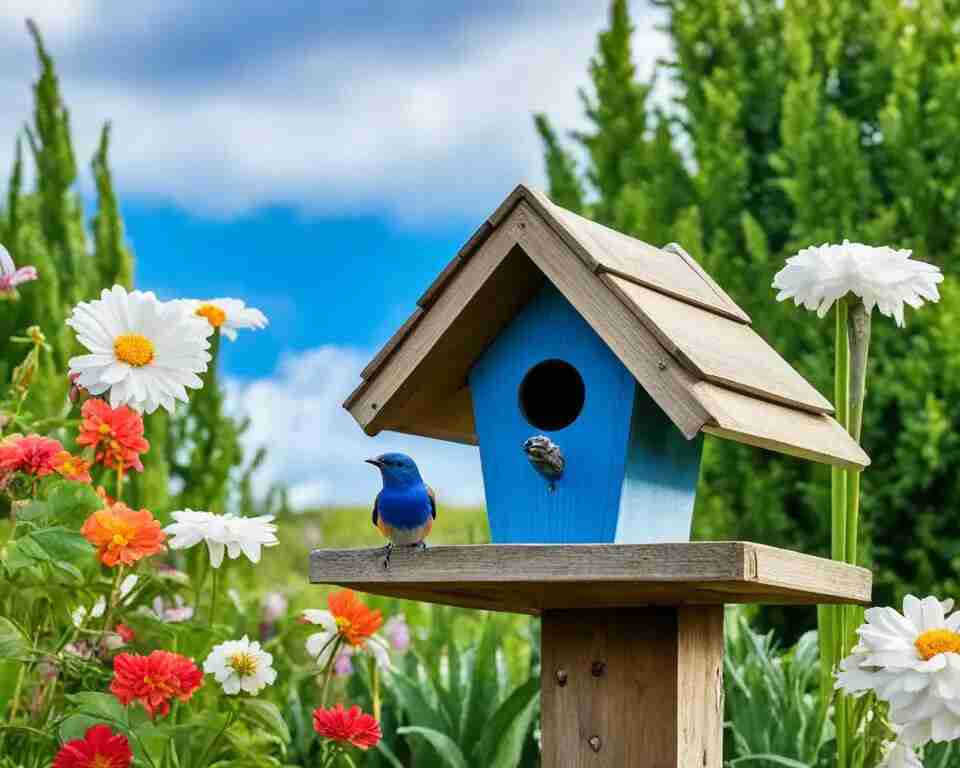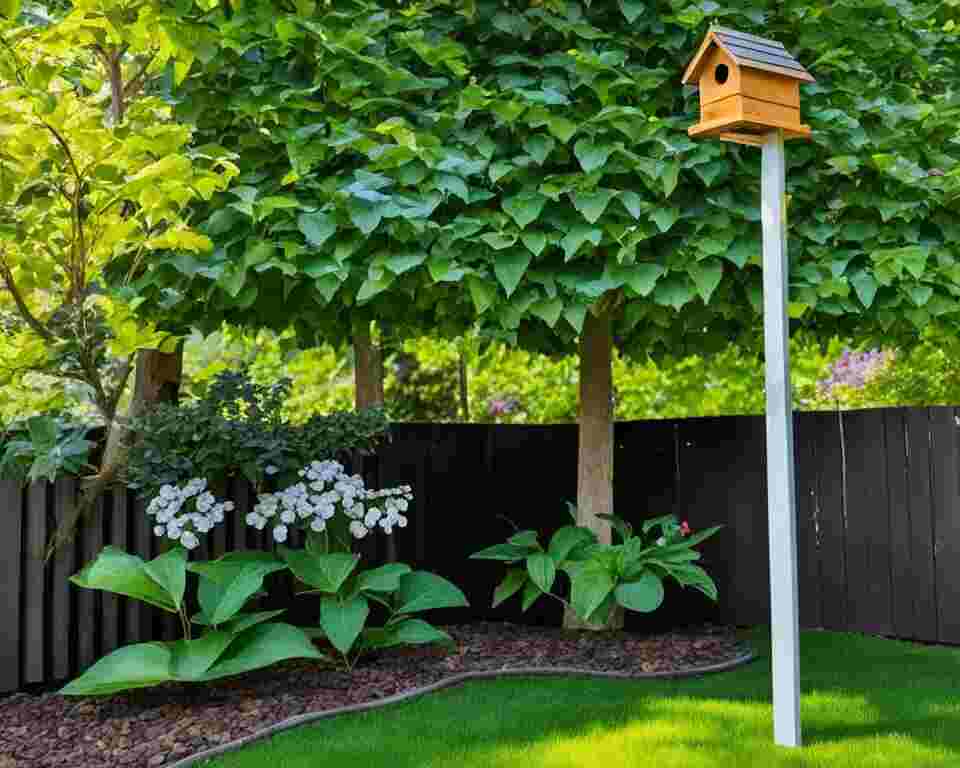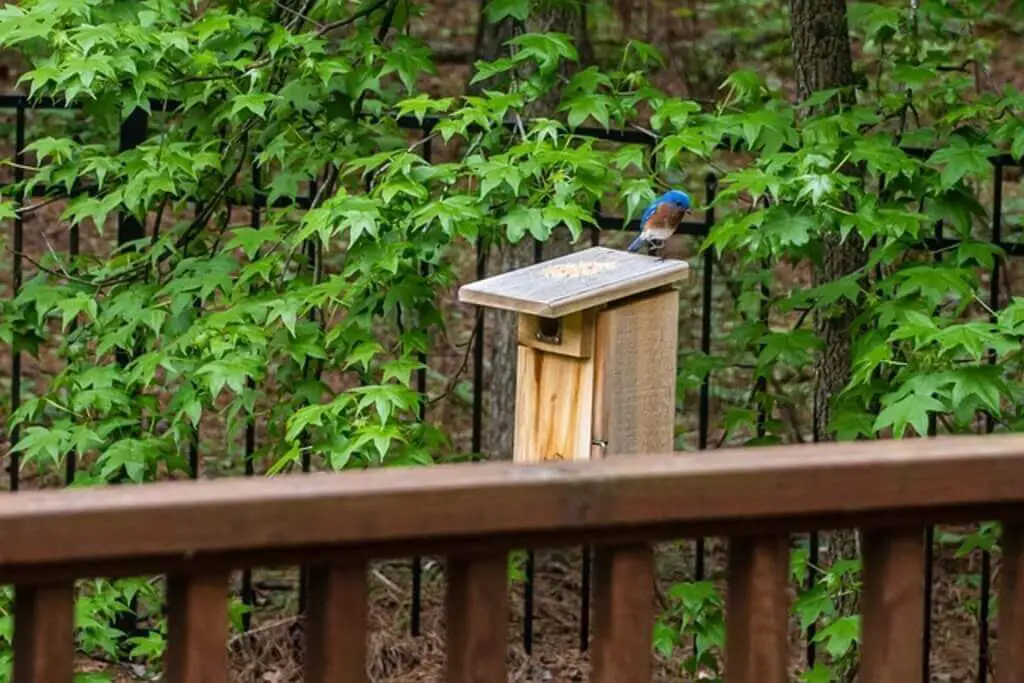As a bluebird enthusiast, creating an ideal habitat for these songbirds is crucial. To attract bluebirds to your garden, understanding what makes the perfect birdhouse is essential.
In this article, I’ll guide you on what to look for in an ideal bluebird house. These insights will empower you to choose a suitable home, creating an inviting environment for bluebirds to make your garden their own.
Table of Contents
Key Takeaways:
- Choosing the best birdhouse for bluebirds is crucial in attracting and providing a safe space for these beautiful songbirds.
- Expert opinions and user reviews help in determining the top birdhouses for bluebirds.
- Creating an inviting environment with the right birdhouse features is essential in attracting bluebirds.
- Bluebirds have specific nesting preferences that should be considered when selecting a birdhouse.
- By choosing a high-quality birdhouse, you contribute to the conservation efforts of bluebirds.

Understanding Bluebird Nesting Preferences
Bluebirds have specific preferences when it comes to nesting. To attract these beautiful birds to your garden, it’s important to understand their nesting habits and create an environment that meets their needs.
One of the key factors in attracting bluebirds is providing nest boxes with optimal features. Experts recommend certain design specifications that bluebirds prefer. These include a small entrance hole (1.5 inches in diameter) to deter larger birds and predators, appropriate dimensions for the nest box, and proper ventilation to regulate temperature and humidity.
It’s also important to consider regional variations that may affect bluebird house design. Different geographic areas may have specific requirements, such as deeper nest boxes to protect against colder climates or specific types of wood that are more resistant to local weather conditions.

In addition to nest box features, creating an inviting environment is crucial in attracting bluebirds. They are attracted to open spaces with short grass or mowed lawns, as these areas provide easy access to insects, which are their main food source. Bluebirds also prefer nesting areas with nearby perching spots, such as trees or fence posts.
By understanding bluebird nesting preferences and creating the right environment, you can successfully attract these beautiful birds to your garden and provide them with a safe space to raise their young.
What is the Best Birdhouse for Bluebirds
In this section, I will review the top-rated bluebird houses available in the market. These birdhouses have proven to be the best options for attracting bluebirds and providing them with a safe and comfortable nesting environment. Let’s explore the features, durability, and user reviews of these top-rated birdhouses.
1. SUQEFAN Bluebird House: This bluebird house from SUQEFAN is highly recommended by experts and bird enthusiasts. It is made of durable cedar wood, which is an ideal material for bluebird houses due to its weather resistance and natural insect-repellent properties. The design of this birdhouse includes a predator guard and a ventilation system, ensuring the safety and comfort of bluebirds.
2. Kingsyard Bluebird House: Another top-rated option is the bluebird house from Kingsyard. It is constructed with high-quality recycled plastic, known for its durability and long-lasting performance. This birdhouse features a well-designed entry hole size specifically suited for bluebirds, preventing larger birds from invading their territory. It also includes an easy-to-open side panel for convenient cleaning.
3. Pennington PRIDE Bluebird House: The bluebird house from Pennington PRIDE is a popular choice among bird enthusiasts. It is crafted with a combination of Eastern Red Cedar and stainless steel screws, ensuring durability and resistance to harsh weather conditions. This birdhouse is designed with an open-front feature, appealing to bluebirds that prefer more open and spacious nesting sites.
| Features | SUQEFAN Bluebird House | Kingsyard Bluebird House | Pennington PRIDE Bluebird House |
|---|---|---|---|
| Material | Cedar wood | Recycled plastic | Eastern Red Cedar |
| Predator Guard | Yes | Yes | Yes |
| Ventilation System | Yes | Yes | Yes |
| Entry Hole Size | Bluebird-specific | Bluebird-specific | Bluebird-specific |
These top-rated bluebird houses have received positive reviews from users who have witnessed bluebirds successfully nesting in them. Their design and materials have proven to be effective in attracting bluebirds and providing them with a safe and suitable habitat. Consider these options when searching for the best birdhouse for bluebirds.
How to Choose the Right Birdhouse Location and Placement
Choosing the right location and placement for a birdhouse is crucial in attracting bluebirds. By considering certain factors, you can create an optimal environment that bluebirds find attractive and safe. Here are some tips to help you choose the right birdhouse location and placement:
- Orientation: Place your birdhouse facing towards the east or northeast, as this provides the birds with protection from the prevailing winds and direct sunlight.
- Height: Mount the birdhouse on a pole or post between 4 and 6 feet above the ground. This ensures the house is at a comfortable height for bluebirds, keeping it safe from predators like cats and raccoons.
- Access: Be sure to keep the area around the birdhouse clear of obstructions, such as branches or vegetation, to allow easy access for bluebirds.
- Privacy: Bluebirds prefer some privacy when nesting. Place the birdhouse at least 50 to 100 feet away from heavily trafficked areas or other birdhouses to reduce competition and disturbances.
- Surroundings: Create a suitable bluebird habitat by placing the birdhouse near open areas with short grass or meadows. Bluebirds are insectivores and prefer nesting close to a reliable food source.

By following these guidelines, you can attract bluebirds to your garden and provide them with an ideal nesting environment. Remember to check the birdhouse regularly for maintenance and cleanliness to ensure the well-being of the bluebirds and the longevity of the birdhouse.
| Location Factor | Recommendation |
|---|---|
| Orientation | Face the birdhouse towards the east or northeast to protect it from wind and direct sunlight. |
| Height | Mount the birdhouse between 4 and 6 feet above the ground to keep it safe from predators. |
| Access | Keep the area around the birdhouse clear of obstructions to allow easy access for bluebirds. |
| Privacy | Place the birdhouse at least 50 to 100 feet away from heavily trafficked areas or other birdhouses for nesting privacy. |
| Surroundings | Position the birdhouse near open areas with short grass or meadows for a suitable bluebird habitat. |
Protecting Bluebird Nestlings: Predator Deterrence and Maintenance
Protecting bluebird nestlings is crucial for their survival. To ensure their safety, it is essential to implement effective predator deterrence strategies and perform regular maintenance on bluebird houses. By taking these precautions, you can create a secure environment for bluebirds to raise their young.
Predator Deterrence:
- Choose appropriate mounting techniques to discourage predators from accessing the nest. Consider using predator guards or baffles on poles or tree trunks to prevent raccoons, snakes, and other climbing predators from reaching the nest.
- Opt for bluebird houses with predator-resistant features, such as small entrance holes to prevent larger birds and animals from entering. A 1.5-inch (3.8 cm) entrance hole is suitable for bluebirds while deterring larger predators.
- Consider installing predator-proof screens or metal plates around the entrance hole to prevent snakes, squirrels, and other predators from widening the hole or reaching the nest.
- Regularly monitor the bluebird house for signs of predation, such as claw marks or damage to the entrance hole. Promptly address any issues to maintain a safe nesting environment.
Seasonal Maintenance:
- Clean out the bluebird house after each nesting season to remove old nesting materials and discourage parasites. Use a small brush or scraper to gently remove debris without damaging the interior of the house.
- Inspect the bluebird house for any signs of wear and tear, including loose screws, cracks, or rotting wood. Repair or replace damaged parts to ensure the structural integrity of the house.
- Check the entrance hole to ensure it remains clear of obstructions, such as spider webs or debris. Clear any blockages to allow easy access for bluebirds.
- Consider adding a predator guard or baffle to an existing bluebird house if you notice repeated predation attempts. This additional measure can help protect the nestlings throughout the breeding season.
By implementing predator deterrence strategies and conducting regular maintenance, you can enhance the safety of bluebird nestlings and increase their chances of survival.

| Predator Deterrence Strategies | Maintenance Tips |
|---|---|
| Choose appropriate mounting techniques | Clean out the bluebird house after each nesting season |
| Opt for predator-resistant features | Inspect for wear and tear regularly |
| Install predator-proof screens or metal plates | Check the entrance hole for obstructions |
| Monitor the bluebird house for signs of predation | Add a predator guard or baffle if necessary |
Conclusion
In conclusion, when it comes to choosing the best birdhouse for bluebirds, it’s essential to consider their nesting preferences, recommended features, and the right location and placement. By following expert recommendations, you can create an inviting and safe environment for bluebirds in your garden.
Bluebirds have specific preferences when it comes to nesting. Providing a birdhouse with the optimal nest box features, such as the right entrance size, ventilation, and drainage, can greatly increase the chances of attracting bluebirds. Additionally, it’s important to consider regional variations that may affect the design of the birdhouse.
Selecting a high-quality birdhouse made of recommended materials, such as cedar or recycled plastic, ensures durability and longevity. The design specifications, including the height of the birdhouse and the distance from potential predators, are crucial factors to consider as well.
To attract bluebirds, it’s crucial to choose the right location and placement for the birdhouse. Bluebirds prefer open areas with nearby perching spots and a water source. Placing the birdhouse facing east or north can also provide protection from the hot afternoon sun. Regular maintenance, such as cleaning out old nests and monitoring for any damage or wear, is important to ensure the safety and attractiveness of the birdhouse.
By creating an inviting environment and taking proper maintenance measures, you not only attract these beautiful songbirds but also contribute to their conservation efforts. Bluebirds play an important role in controlling insect populations and add beauty and joy to any garden. So, invest in a quality birdhouse and enjoy the presence of bluebirds in your outdoor space!


